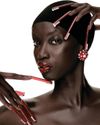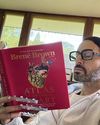
Long before the summer showing of Schiaparelli’s couture collection, Daniel Roseberry, the house’s creative director, gathered his thoughts as he always did: by starting from the future that he hoped to reach. He imagined a review of the collection in the press, and wrote a version of it, line by line. He grew up in Texas and, on arriving in Paris to lead Schiaparelli toward a new phase of growth in 2019, worked to find a narrative order for the rangy span of his creative life. Roseberry loves reviews, their clarity and judgment—given the choice, he’d often rather read reviews of movies than see them. Imagining a critic approaching his fashion helps him find its big emotions, its broad sweep. “If I can identify and anticipate in my mind what people want to see, I can work backward,” he explained. “How do I make that review come to life?”
A few months later, Roseberry is assessing a brown felt coat with a swirling, cowl-like lapel being walked up and down the room before him by a model with neat auburn hair. This is Paris, early July, and the couture collection he imagined in the spring will travel down the runway in just two days’ time. At the moment, more than two dozen pieces, four tables of accessories, and a cast of models must be matched and gathered into a coherent whole. If he fails, his runway will seem scattershot and random. If he succeeds, the collection will achieve its own daring inevitability: the haunted rightness of a strange dream brought to life.
“Some of these could be good,” he murmurs, picking up bonelike gold-and-stone extensions, to be used as earrings.
“Separate?” one of the models asks.
Roseberry nods. “One, two,” he says, gesturing at his own ears.
Diese Geschichte stammt aus der September 2023-Ausgabe von Vogue US.
Starten Sie Ihre 7-tägige kostenlose Testversion von Magzter GOLD, um auf Tausende kuratierte Premium-Storys sowie über 8.000 Zeitschriften und Zeitungen zuzugreifen.
Bereits Abonnent ? Anmelden
Diese Geschichte stammt aus der September 2023-Ausgabe von Vogue US.
Starten Sie Ihre 7-tägige kostenlose Testversion von Magzter GOLD, um auf Tausende kuratierte Premium-Storys sowie über 8.000 Zeitschriften und Zeitungen zuzugreifen.
Bereits Abonnent? Anmelden

FINAL CUT
\"WE WANT YOU TO GO FOR IT!\" ANNA TOLD ME

SCREEN TIME
Three films we can't wait to see.

Impossible Beauty
Sometimes, more is more: Surreal lashes and extreme nails put the fierce back in play

Blossoms Dearie
Dynamic, whimsical florals and the humble backdrops of upstate New York make for a charming study in contrasts.

HOME
Six years ago, Marc Jacobs got a call about a house designed by Frank Lloyd Wright. Making it his own, he writes, would be about love, commitment, anxiety, patience, struggle, and, finally, a kind of hard-fought, hard-won peace.

GIRL, INTERRUPTED
Anna Weyant found extraordinary fame as an artist before she had reached her mid-20s. Then came another kind of attention. Dodie Kazanjian meets the painter at the start of a fresh chapter

ROLE PLAY
Kaia Gerber is someone who likes to listen, learn, read books, go to the theater, ask questions, have difficult conversations, act, perform, transform, and stretch herself in everything she does. That she's an object of beauty is almost beside the point.

CALLAS SHEET
Maria Callas's singular voice made her a legend on the stage. In a new film starring Angelina Jolieand on the runwaysthe romance continues.

BOOK IT
A preview of the best fiction coming

GLOBAL VISTAS
Three new exhibitions offer an expansive view.